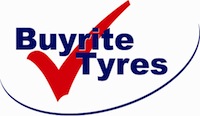Tyre Pressures
Check your tyre pressures regularly and before long trips and do not forget the spare. The pressure should be checked when the tyres are cold as tyre pressure increase while the vehicle is driven. Finally, the valve cap is an essential component for a completely air tight seal. We can supply plastic dust caps to our customers free of charge. If you are unsure of your tyre pressures or how to set them please tell us using the contact page or give us a call.
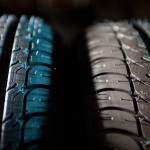
Tread depth limit
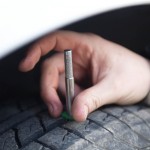 For Cars, vans & 4x4s, in the UK the minimum legal tread depth is 1.6mm in a continuous band, comprising the central three quarters of the tread area, around the entire circumference of the tyre.
For Cars, vans & 4x4s, in the UK the minimum legal tread depth is 1.6mm in a continuous band, comprising the central three quarters of the tread area, around the entire circumference of the tyre.
Tyres also have tread wear indicators (TWI) which give the driver an indication as to whether or not they are approaching their limit of wear. With reduced remaining tread depth, the risk of skidding on wet surfaces increases.
Valves
For safety reasons, a new tubeless valve should be fitted whenever a tyre is mounted to a tubeless wheel, this is important when a new tyre is fitted or when repairs to current tyre takes place. Where tyre pressure monitoring valves are present, the valve should be fitted using the correct service kit.
New to Rear
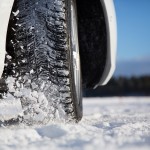 For reasons of road holding, when replacing tyres in most cases we recommend, whether your vehicle is front or rear wheel drive, the newer / younger tyres are placed on the rear axle of the vehicle. This is to stabilise the vehicle and the higher tread helps when under breaking the rear axle load decreases. On a front wheel drive the new to rear rule helps as aged tyres would be moved to the front axle were they can be worn before age related issues occur.
For reasons of road holding, when replacing tyres in most cases we recommend, whether your vehicle is front or rear wheel drive, the newer / younger tyres are placed on the rear axle of the vehicle. This is to stabilise the vehicle and the higher tread helps when under breaking the rear axle load decreases. On a front wheel drive the new to rear rule helps as aged tyres would be moved to the front axle were they can be worn before age related issues occur.
Why do you not offer Nitrogen Inflation?
- The molecules of Nitrogen are allegedly larger than oxygen thus providing a more stable inflation pressure.
- Nitrogen is more stable under temperature fluctuations hence maintaining a more consistent inflation pressure.
- Nitrogen has a lower moisture content and hence has less corrosive effect on the tyre and wheel.
Promoters use the more stable and consistent inflation pressure argument as providing better tyre mileage, better fuel consumption and better tyre casing durability. All of this may be true, but to what degree? The size of a Nitrogen molecule is very comparable with that of oxygen and as air is made up of about 80% nitrogen the effect on slow leakage will be very small. The temperature fluctuation in tyres in everyday use is small and pressure increases or decreases have never presented a problem, providing the tyre is correctly inflated in the first instance. Given that tyres have been designed around normal air inflation for approaching a century and Nitrogen even longer, then if there was any significant advantage, Nitrogen would be the common inflation media, which it is not.
Tyre Damage
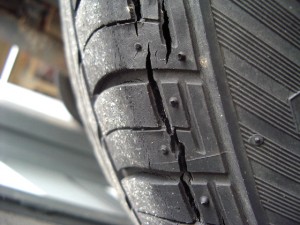 Any visible damage i.e. sidewall or tread deformation, deep cuts or split etc., must be inspected quickly to prevent premature failure or possibly to facilitate a repair. Abnormalities in vehicle ride or handling i.e. vibration, pulling to one side, excessive noise, etc. also requires early diagnosis to establish whether the tyre is defective and to prevent wear to other components.
Any visible damage i.e. sidewall or tread deformation, deep cuts or split etc., must be inspected quickly to prevent premature failure or possibly to facilitate a repair. Abnormalities in vehicle ride or handling i.e. vibration, pulling to one side, excessive noise, etc. also requires early diagnosis to establish whether the tyre is defective and to prevent wear to other components.
Common Wear Issues
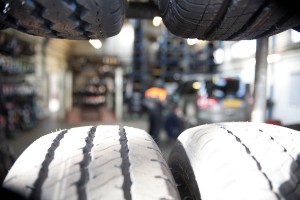 Alignment Wear
Alignment Wear
Observation: Wear increasing from one edge to the other with a fine rubber flash or feathering present on the longitudinal edges.
Probable Cause: Incorrect alignment of the front or rear wheels.
Advise : Tyres – Can be kept in use if they meet the legal requirements.
Vehicle – Adjust the wheel alignment to the manufacturers.
Centre Wear
Observation: Wear more pronounced in the centre of the tread than the shoulders.
Probable Cause: Tyre over inflated.
Advise: Verify and reset the tyre pressures to the manufacturer specification. The tyre can be kept in use if it meets the legal requirements.
Rounded Wear
Observation: Wear more pronounced on the shoulders than the centre of the tread.
Probable Cause: Tyre under inflated or over loaded.
Advise: Look for the cause of under inflation and correct it (negligence, puncture, heavy tools etc. The tyre can be kept in use if it meets the legal requirements and the structure of the tyre has not been affected.
Irregular Wear
Observation: Irregular wear in ripples, bands facets. Droning noise similar to that of a worn wheel bearing.
Probable Cause(s): Generally found on trailing rear axles. This kind of wear can be a result of the combination of several vehicle factors such as incorrect geometry setting or suspension faults although this wear issue is often present on vehicles without such issue so may be considered normal wear.
Advise: Tyre – can be kept in use if it meets the legal requirements and does not cause vibration. Move the tyre to a driven axle as long as it meets legal requirements and does not cause vibration, this should help prevent the wear irregularities from worsening.
Vehicle – Check the wheel alignment and suspension. If no fault is found frequent tyre inspection will be required for this vehicle.
Deformation
Observation: Localised blister(s) or bulge(s) with or without signs of impact (cut, grazing etc.).
Probable Cause: Accidental damage, rupture of one or more cord in the tyres casing structure caused by contact with an obstacle (pavement, pot-hole etc.) or nipping of the sidewall between an obstacle and the wheel rim edge. This type of damage is exacerbated by under-inflation and overloading.
Advise: Tyre – To be discarded.
Garage services
You can book your MOT with us just click the link
